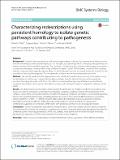| dc.contributor.author | Platt, Daniel E. | en_US |
| dc.contributor.author | Basu, Saugata | en_US |
| dc.contributor.author | Zalloua, Pierre A. | en_US |
| dc.contributor.author | Parida, Laxmi | en_US |
| dc.date.accessioned | 2016-07-14T19:17:39Z | |
| dc.date.issued | 2016 | en_US |
| dc.identifier.citation | Platt, Daniel E., Saugata Basu, Pierre A. Zalloua, and Laxmi Parida. 2016. “Characterizing redescriptions using persistent homology to isolate genetic pathways contributing to pathogenesis.” BMC Systems Biology 10 (Suppl 1): 10. doi:10.1186/s12918-015-0251-2. http://dx.doi.org/10.1186/s12918-015-0251-2. | en |
| dc.identifier.issn | 1752-0509 | en |
| dc.identifier.uri | http://nrs.harvard.edu/urn-3:HUL.InstRepos:27662233 | |
| dc.description.abstract | Background: Complex diseases may have multiple pathways leading to disease. E.g. coronary artery disease evolves from arterial damage to their epithelial layers, but has multiple causal pathways. More challenging, those pathways are highly correlated within metabolic syndrome. The challenge is to identify specific clusters of phenotype characteristics (composite phenotypes) that may reflect these different etiologies. Further, GWAS seeking to identify SNPs satisfying multiple composite phenotype descriptions allows for lower false positive rates at lower α thresholds, allowing for the possibility of reducing false negatives. This may provide a window into the missing heritability problem. Methods: We identify significant phenotype patterns, and identify fuzzy redescriptions among those patterns using Jaccard distances. Further, we construct Vietoris-Rips complexes from the Jaccard distances and compute the persistent homology associated with those. The patterns comprising these topological features are identified as composite phenotpyes, whose genetic associations are explored with logistic regression applied to pathways and to GWAS. Results: We identified several phenotypes that tended to be dominated by metabolic syndrome descriptions, and which were distinct among the combinations of metabolic syndrome conditions. Among SNPs marking the RAAS complex, various SNPs associated specifically with different groups of composite phenotypes, as well as distinguishing between the composite phenotypes and simple phenotypes. Each of these showed different genetic associations, namely rs6693954, rs762551, rs1378942, and rs1133323. GWAS identified SNPs that associated with composite phenotypes included rs12365545, rs6847235, and rs701319. Eighteen GWAS identified SNPs appeared in combinations supported in composite combinations with greater power than for any individual phenotype. Conclusions: We do find systematic associations among metabolic syndrome variates that show distinctive genetic association profiles. Further, the systematic characterization involves composite phenotype descriptions that allow for combined power of individual phenotype GWAS tests, yielding more significance for lower individual thresholds, permitting the exploration of SNPs that would otherwise show as false negatives. | en |
| dc.language.iso | en_US | en |
| dc.publisher | BioMed Central | en |
| dc.relation.isversionof | doi:10.1186/s12918-015-0251-2 | en |
| dc.relation.hasversion | http://www.ncbi.nlm.nih.gov/pmc/articles/PMC4895260/pdf/ | en |
| dash.license | LAA | en_US |
| dc.subject | Pattern discovery | en |
| dc.subject | Redescription | en |
| dc.subject | Persistent homology | en |
| dc.subject | Genetic association | en |
| dc.subject | GWAS | en |
| dc.subject | Missing heritability | en |
| dc.title | Characterizing redescriptions using persistent homology to isolate genetic pathways contributing to pathogenesis | en |
| dc.type | Journal Article | en_US |
| dc.description.version | Version of Record | en |
| dc.relation.journal | BMC Systems Biology | en |
| dash.depositing.author | Zalloua, Pierre A. | en_US |
| dc.date.available | 2016-07-14T19:17:39Z | |
| dc.identifier.doi | 10.1186/s12918-015-0251-2 | * |
| dash.contributor.affiliated | Zalloua, Pierre | |


